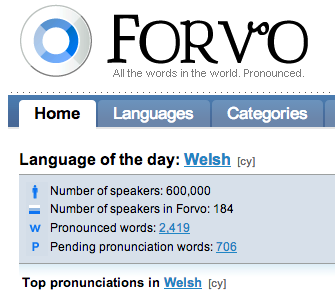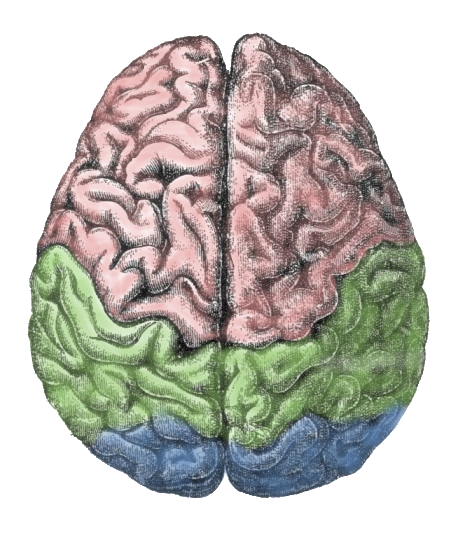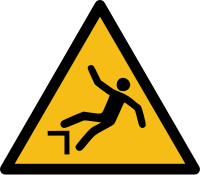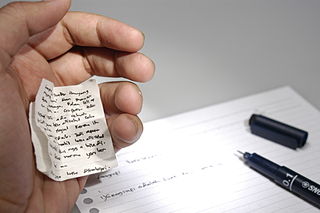
Teachers use these for:
- formative assessment
- getting class opinions
- helping students do group work
- taking attendance in large classes
Keeping up with the latest developments in learning, teaching, and technology

Teachers use these for:
Forvo is a kind of pronunciation exchange. Users can add requests to hear various language speakers pronounce a word. These pronunciations are recorded and playable online, so students can find out how real people pronounce a word. Yes, these people are not linguists nor language teachers (necessarily), but if you travel to another country, what are the chances that you’ll meet a linguist or language teacher who will sound like a language teacher?
 Forvo has pronunciations in over 299 languages, with the most pronunciations in:
Forvo has pronunciations in over 299 languages, with the most pronunciations in:
Imagine being able to use an example from a native speaker in your language class and not have to rely on finding a youtube video or song with that word in it.
Eyeo is a three day conference that takes place in Minneapolis, MN. It is a gathering where many come to explore and learn about art, technology, information and the interaction of all three. The festival’s tagline is “Converge to Inspire,” and inspire it does.
Since its iteration (2011) there has been a clear spike in interest. Last year the event sold out in eight hours, this year it sold out in less than three. Topics and talks range from creative coding, to data visualization, to new media, all the way to wearable technologies. There were many talks that inspired me to create and delve deeper into the “maker” side of the digital humanities, but there was one talk in particular that left an impression on me. Amit Pitaru’s Sharp Corners focused on the evolution of his work, installations, how we learn, and problem solving. It was the part about how we learn that left me with a warm fuzzy. Watch his talk below to see his work and how he explains learning curve.
Eyeo 2013 – Amit Pitaru from Eyeo Festival on Vimeo.

The research comes out as the idea of a "flipped classroom," in which students first watch videos or read texts and then do projects in the classroom, has been growing in popularity at colleges and graduate schools. The study's conclusion suggests that the current model of the flipped classroom should itself be flipped upside down. The researchers advocate the "flipped flipped classroom," in which videos come after exploration and not before.
via Classes should do hands-on exercises before reading and video, Stanford researchers say.
If we do pre-lecture activities in class, “lectures” and readings at home as “homework” and then advanced things during the next class period, this still allows us to do the more fun advanced things in class. In other words, class sessions can be split between doing advanced application of the reading/lectures, then doing pre-lecture “discovery” toward the end of class, which could connect it to the previously-learned material.
Anyone interested in doing a follow-up study to see if this works without the BrainExplorer (here’s a post where they built the BrainExplorer) or in other subject areas?
This summer, we worked on making a 3D map of the library to show patrons where various things are located. The ultimate goal has been to print it as a sort of easy reference guide which shows what is located where in relation to other floors.
It occurred to me that it would be handy to simply put the model online so that people could zoom in and see what they needed by themselves. A quick search revealed that this is possible by using a modern web browser and no plugins. Continue reading “Displaying 3D models online”

A recently retired high school teacher wrote:
My students did well on those [AP Exam] questions because we practiced bad writing. My teaching was not evaluated on the basis of how well my students did, but I felt I had a responsibility to prepare them for the examination in a way that could result in their obtaining college credit.
I would like to believe that I prepared them to think more critically and to present cogent arguments, but I could not simultaneously prepare them to do well on that portion of the test and teach them to write in a fashion that would properly serve them at higher levels of education.
via A warning to college profs from a high school teacher.
Do we really have to choose among writing well, thinking well and scoring highly on exams? Here at Colorado College, we have multiple structures in place to help. Writing Intensive classes should help students become better writers, especially if they visit the writing center for a consultation. We’ve also got Quantitative Reasoning classes and the QRC, which should help the students think better as well. Finally, all classes at CC should help the students hone their analysis and reasoning skills, which will help them score well on exams.
Of course, by virtual labs, they don’t mean virtual computer labs, but virtual science labs. Dissections on a computer screen and that kind of thing to make it so classes which require physical skills are no longer a bottleneck due to physical equipment limitations. The nice thing about virtual labs is that they can be clean. You can create a friction-free environment, have organs that are in good shape and in the right place, and have reactions that happen as they should.
The California State University System may bet big on virtual labs starting this fall, a sign of how heavily some policy makers are counting on technology to solve funding problems.
I saw this article this morning and thought it was interesting. What are things we’re doing because we’re used to them and not necessarily the best way of doing them? How can we move past nostalgia and into the present or even the future?
I’m not saying that all skills and methods used “long ago” are irrelevant, but Continue reading “Holding on”
I think everyone wants to maximize the time they spend doing enjoyable things and minimize the time they spend doing drudgery.
Similarly, I think we’d all like to spend less time carrying assignments around, marking them up and handing them back to students, especially when not all the students get their papers back the first time around. minimize drudgery. David Sivers, founder of CD Baby, created a way to automatically send an email when a CD shipped to its purchaser. That was one less thing someone had to do.

James M. Lang reports on a book about dishonesty in the first part of a three articles on cheating on the Chronicle of Higher Ed. The article and book discuss findings on cheating.
An earlier article in the Chronicle discussed a MOOC that teaches students how to cheat. Of course, this is done so that participants can better learn how to prevent cheating. I think in many cases, exams should mirror tasks that would happen in the real world, where possible. We want students to learn how to research, analyze, and draw reasonable conclusions. Continue reading “Cheating Lessons, Part 1 – The Chronicle of Higher Education”